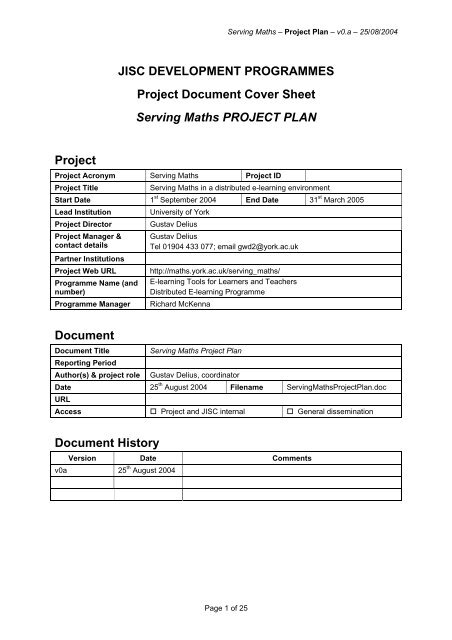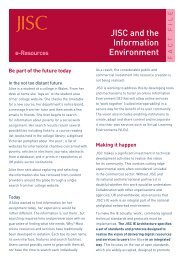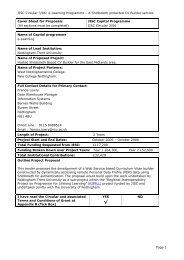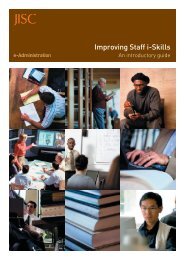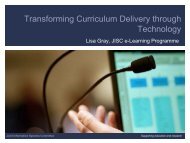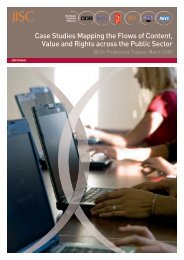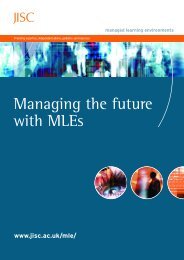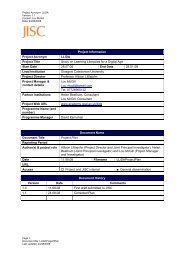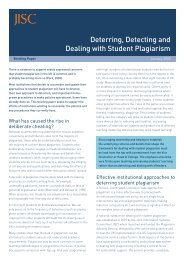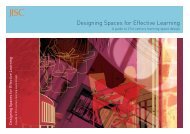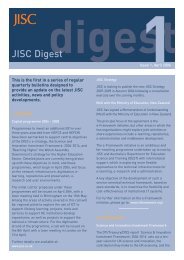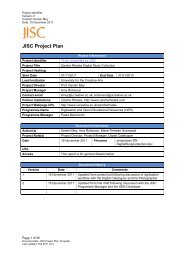Serving Maths Project Plan - Jisc
Serving Maths Project Plan - Jisc
Serving Maths Project Plan - Jisc
You also want an ePaper? Increase the reach of your titles
YUMPU automatically turns print PDFs into web optimized ePapers that Google loves.
<strong>Serving</strong> <strong>Maths</strong> – <strong>Project</strong> <strong>Plan</strong> – v0.a – 25/08/2004<br />
JISC DEVELOPMENT PROGRAMMES<br />
<strong>Project</strong> Document Cover Sheet<br />
<strong>Serving</strong> <strong>Maths</strong> PROJECT PLAN<br />
<strong>Project</strong><br />
<strong>Project</strong> Acronym <strong>Serving</strong> <strong>Maths</strong> <strong>Project</strong> ID<br />
<strong>Project</strong> Title<br />
<strong>Serving</strong> <strong>Maths</strong> in a distributed e-learning environment<br />
Start Date 1 st September 2004 End Date 31 st March 2005<br />
Lead Institution<br />
<strong>Project</strong> Director<br />
<strong>Project</strong> Manager &<br />
contact details<br />
Partner Institutions<br />
<strong>Project</strong> Web URL<br />
Programme Name (and<br />
number)<br />
Programme Manager<br />
University of York<br />
Gustav Delius<br />
Gustav Delius<br />
Tel 01904 433 077; email gwd2@york.ac.uk<br />
http://maths.york.ac.uk/serving_maths/<br />
E-learning Tools for Learners and Teachers<br />
Distributed E-learning Programme<br />
Richard McKenna<br />
Document<br />
Document Title<br />
<strong>Serving</strong> <strong>Maths</strong> <strong>Project</strong> <strong>Plan</strong><br />
Reporting Period<br />
Author(s) & project role Gustav Delius, coordinator<br />
Date 25 th August 2004 Filename <strong>Serving</strong><strong>Maths</strong><strong>Project</strong><strong>Plan</strong>.doc<br />
URL<br />
Access <strong>Project</strong> and JISC internal General dissemination<br />
Document History<br />
Version Date Comments<br />
v0a 25 th August 2004<br />
Page 1 of 25
<strong>Serving</strong> <strong>Maths</strong> – <strong>Project</strong> <strong>Plan</strong> – v0.a – 25/08/2004<br />
Overview of <strong>Project</strong><br />
1. Background<br />
E-learning and e-assessment meet special challenges when it comes to the teaching of<br />
mathematical skills. Special tools and systems have been developed by the subject<br />
community to address these challenges, many of them—including the systems presented<br />
here—very sophisticated. However, the widespread adoption of these tools has been hindered<br />
by a lack of standards and interoperability.<br />
We will extend and adapt existing mathematical e-learning tools and systems, developed by<br />
members of the project team, to make them interoperable with other components of a<br />
managed learning environment, as well as with one another. This will be done using and<br />
extending e-learning standards and web service protocols.<br />
We will extend the following existing systems and make them interoperable:<br />
• AiM and CABLE are self-testing and assessment systems based on server-side<br />
marking using computer algebra, allowing for testing of higher mathematical skills;<br />
• METRIC is a self-testing and mathematical learning system based on client-side<br />
marking implemented in Java, allowing for scalability and use off-line.<br />
• WaLLiS is an interactive learning environment that focuses on providing adaptive and<br />
intelligent feedback for mathematics questions.<br />
• Moodle is a user-friendly VLE with an assessment system that we will extend.<br />
These tools have already been proven at several institutions to provide great pedagogical<br />
benefit to the learning experience of students of mathematics and related disciplines, both in<br />
higher education and at the school-university interface.<br />
2. Aims and Objectives<br />
Our aim is to provide lecturers with convenient and easy-to-use tools to create computer<br />
aided assessment questions for mathematics and to integrate them as seamlessly as possible<br />
into their existing teaching practice.<br />
In the field of mathematics, a would-be author of question items currently faces a number of<br />
problems. The only generally available, interoperable, standards-compliant authoring tools<br />
will allow her to create questions of a general type, such as multiple-choice, textual input or<br />
numerical input. However, they will not allow her to format mathematical expressions, or to<br />
generate such expressions from parameter sets, or to create items that assess student answers<br />
in the form of such expressions. The overall aim of the project is to solve these problems, by<br />
pooling and enhancing the non-generic solutions already developed by members of the team.<br />
It is our aim that the tools we develop will be easy to integrate into existing e-learning<br />
environments and existing assessment systems. They should be easy to install, either by an<br />
individual lecturer or centrally by a whole institution.<br />
A further aim of this project is to make it easier for developers of e-learning tools to equip<br />
their tools with the extra capabilities required for mathematics.<br />
Our objectives are:<br />
Page 2 of 25
<strong>Serving</strong> <strong>Maths</strong> – <strong>Project</strong> <strong>Plan</strong> – v0.a – 25/08/2004<br />
1. To develop a Web Service for the delivery of mathematical expressions. This service<br />
will be able to be called by any e-learning tool; it will respond appropriately to the<br />
capabilities of the user's browser and to his/her preferences, and will provide a choice<br />
of input tools (some of which have already been developed by members of the team).<br />
It will make available free-floating mathematical tools developed by team members,<br />
as well as fronts ends to server-side computer algebra systems.<br />
2. To produce an XML specification to represent mathematical questions. The<br />
specification will reflect the particular nature of the subject: specifically, the need to<br />
assess student answers that are in the form of mathematical expressions. This will be<br />
implemented in AiM, CABLE and METRIC. We shall work closely with the<br />
MathML. OpenMath and IMS communities internationally.<br />
3. To develop an authoring tool for mathematics question items, providing teachers with<br />
simple interfaces that allow questions to be written without the need to become<br />
familiar with the underlying formats. This tool shall accept plug-ins for various<br />
question types.<br />
4. To develop a web services protocol with which existing assessment systems can<br />
communicate with our mathematical assessment engines to allow them to incorporate<br />
mathematical questions into their quizzes.<br />
5. To develop tools with which lecturers can seamlessly integrate computer aided<br />
assessment questions into their traditional problem sheets.<br />
3. Overall Approach<br />
Strategy and structuring<br />
The project is based around 5 existing and three new software packages. The existing<br />
packages are<br />
• AiM<br />
• CABLE<br />
• METRIC<br />
• Moodle<br />
• WaLLiS<br />
The three new packages to be developed by the project are<br />
• a question authoring tool with plug-ins for different question types<br />
• a web service for representing mathematics on the web<br />
• a tool allowing lecturers to manage both their conventional assignment questions and<br />
their computer aided questions and to combine them seamlessly into problem sheets.<br />
The project will tie these tools together by several web services protocols<br />
and interoperability specifications:<br />
• a web service protocol for communication between assessment systems and question<br />
engines<br />
Page 3 of 25
<strong>Serving</strong> <strong>Maths</strong> – <strong>Project</strong> <strong>Plan</strong> – v0.a – 25/08/2004<br />
• a syntax specification and web service protocol for communication with the service<br />
taking care of the presentation of mathematics on the web<br />
• a specification for mathematical questions<br />
This structure of working on 8 independent software projects, tied together by web services<br />
protocols and interoperability specifications makes management of this project easier as<br />
would otherwise be the case for a project with a geographically distributed team.<br />
The strong reliance on web service protocols and interoperability specifications however<br />
serves another purpose: it will make it possible for other mathematical software, not included<br />
in this project, to achieve interoperability with our tools by implementing the same protocols<br />
and specifications.<br />
Scope and boundaries<br />
The project is focused on the development and implementation of standards, services and<br />
implementations for authoring and deploying question test items in mathematics. Within this,<br />
our central concern is mathematical expressions: their generation, rendering and comparison<br />
as mathematical objects. The project is not concerned with wider e-learning issues in<br />
mathematics, such as microworlds, intelligent tutoring, course management or assessment of<br />
sustained mathematical argument.<br />
Neither is the project committed to dealing with the issue of graphics in question tests. This<br />
issue has, however, been addressed by several of the individual team members in their nongeneric<br />
projects, and the work may reveal opportunities to build on these achievements. Any<br />
such opportunities will be taken advantage of if time, and other project commitments, allows<br />
it.<br />
Important issues and critical success factors<br />
Interoperability lies at the heart of the project's aims, and indeed a large mid-project<br />
milestone has been scheduled that consists in demonstrating interoperability among all<br />
components developed thus far. Achieving interoperability is central to the project's success,<br />
as is compliance with existing and emerging standards (for example, those for QTI in<br />
general).<br />
Of at least equal importance is ease of use. Since the project's overall aim is to enable<br />
colleagues to create mathematical question test items without becoming expert programmers,<br />
the ensemble of services, standards, implementations and authoring tools that the project<br />
produces must be usable in a natural and intuitive way, and without extensive training. Also,<br />
at the learner's end, the project's implementations must generate questions that are themselves<br />
easy to use. In particular, questions must test, as far as possible, the learner's knowledge of<br />
mathematics only, and not of specialised, non-intuitive notations and conventions.<br />
Pedagogical soundness cannot be directly guaranteed, because it is always possible to use<br />
good tools badly. Nonetheless, the project's deliverables must lend themselves to<br />
pedagogically sound use. Specifically, they must enable the creation of cognitively rich<br />
question items that assess as many aspects as possible of mathematical thinking, at as many<br />
levels as possible in a Bloom-type taxonomy of objectives. Cognitive richness must come<br />
without a major cost in interoperability or ease of use, and must not require the author to<br />
Page 4 of 25
<strong>Serving</strong> <strong>Maths</strong> – <strong>Project</strong> <strong>Plan</strong> – v0.a – 25/08/2004<br />
acquire arcane expertise. It must manifest itself in tasks for the learner whose richness of<br />
challenge lies solely in their mathematical content, and not in any fresh computational or user<br />
interface problems.<br />
4. <strong>Project</strong> Outputs<br />
The following is a list of deliverables, organized into 5 sections. The meaning of some of the<br />
items in the list will become clearer after the description of the 5 sections which follows the<br />
list.<br />
1. DOME: a web service for mathematical expressions<br />
1. A syntax and protocol specification for the service<br />
2. An implementation of the service<br />
3. Client interfaces in<br />
1. Moodle<br />
2. AiM<br />
3. CABLE<br />
4. METRIC<br />
5. WaLLiS<br />
4. User documentation, website, support forum<br />
5. Developer documentation, SourceForge CVS repository<br />
2. Interoperability for mathematics questions<br />
1. Workshop to discuss proposals for maths QTI<br />
2. A maths QTI specification<br />
3. Rendering and marking of maths QTI questions in<br />
1. AiM<br />
2. CABLE<br />
3. METRIC<br />
4. A community website and discussion forum about maths QTI<br />
5. A repository for maths QTI questions<br />
3. Authoring tools for mathematical assessment questions<br />
1. maths QTI authoring tool with plug-in architecture<br />
2. Authoring tool plug-ins for<br />
1. differentiation questions<br />
2. integration questions<br />
3. matrix questions<br />
4. spread-sheet style questions<br />
5. adaptive questions<br />
3. Integration of authoring tool into Moodle<br />
4. Interface between authoring tool and maths QTI repository<br />
5. User documentation, website, support forum<br />
6. Developer documentation, SourceForge CVS repository<br />
4. Extensible assessment systems<br />
1. Workshop about the architecture of extensible assessment systems<br />
2. A specification of a RemoteQuestionProtocol (jointly with APIS)<br />
3. Implementations of RQP server interfaces in<br />
1. AiM<br />
Page 5 of 25
<strong>Serving</strong> <strong>Maths</strong> – <strong>Project</strong> <strong>Plan</strong> – v0.a – 25/08/2004<br />
2. CABLE<br />
4. RQP client interfaces in<br />
1. Moodle<br />
2. METRIC<br />
3. WaLLiS<br />
5. Developer documentation<br />
5. Computer aided problem sheets<br />
1. Unified question management tool for both conventional and computerized<br />
problem<br />
2. Extension of Moodle VLE to manage and conduct assessment of problem<br />
sheets<br />
3. Teacher manual, Student manual, Collection of example problem sheets<br />
4. Developer documentation<br />
We now describe each of the 5 main parts in more details, repeating some information from<br />
the project proposal.<br />
DOME: a web service for the delivery of mathematical expressions<br />
In order for any on-line learning material or tool to be useful for mathematics and science<br />
teaching it needs a way to allow the user to enter and view mathematical formulas. This is<br />
currently a problem for web-based solutions because the MathML standard is not yet<br />
sufficiently supported by most browsers. Many of the work-around solutions (like converting<br />
formulas to images or to HTML) are unsatisfactory because they do not meet accessibility<br />
criteria.<br />
In order to deliver formulas appropriately to all users they need to be translated into a variety<br />
of formats depending on the capabilities of the user's browser and the user's preferences. A<br />
visually impaired user for example needs to be able to set an option to receive formulas in<br />
particularly large font size or have them delivered in the form required by a screen reader.<br />
Most existing components of virtual leaning environments (bulletin boards and discussion<br />
forums, chat areas, messaging systems, collaboration tools and assessment tools) do not<br />
currently provide sufficient support for mathematics. One solution would be to replace all<br />
these components by ones suitable for mathematics. We propose an alternative and more<br />
feasible solution: We will develop a web service that can be called by any e-learning tool and<br />
takes care of all matters related to the display of mathematical expressions:<br />
• managing user preferences and detecting the type of browser used,<br />
• dynamically converting the expressions into the most suitable form, given the user's<br />
preferences and the capabilities of the user's browser,<br />
• providing a choice of input tools and other mathematical tools.<br />
Performing these tasks in a dedicated service rather than in each individual e-learning tool<br />
has several advantages:<br />
• the development effort for mathematics-aware e-learning tools is reduced,<br />
• users only have to specify their preferences once for all e-learning tools,<br />
• the display occurs in a consistent style across all e-learning tools,<br />
• the display methods can more easily be kept up-to date.<br />
Page 6 of 25
<strong>Serving</strong> <strong>Maths</strong> – <strong>Project</strong> <strong>Plan</strong> – v0.a – 25/08/2004<br />
This service is particularly important because it ensures that all learning material will be<br />
accessible to students with disabilities. This is done automatically behind the scenes without<br />
extra effort from the teacher. The ad-hoc methods for the delivery of mathematics used in the<br />
past were very problematic in this respect. Our current code name for this service is DOME<br />
(Delivering Online Mathematics to Everyone)<br />
The service will be able to translate expressions from OpenMath, MathML or LaTeX format<br />
(enclosed by special markup tags) into the most appropriate format for the user. This will be<br />
achieved by using a variety of open-source converters. Results of the more time-consuming<br />
conversions will be cached for efficiency reasons, using a system already in use in Moodle.<br />
The service will probably be defined via WSDL, communicate via SOAP and register itself<br />
via UDDI, or alternatively we might use XML-RPC.<br />
The service will be able to evaluate a range of mathematical expressions using an open<br />
source computer algebra system (probably Maxima) and to return the result to the calling<br />
system.<br />
The service will also deal with markup tags for input elements that will be translated into the<br />
user’s preferred input tool for mathematics. Instead of a plain text input box the user will be<br />
able to choose for example the METRIC tool, which typesets the input, keystroke-bykeystroke,<br />
as 2D mathematics.<br />
Finally there will be markup for including a preferences panel or a link to it. For handling of<br />
this preference information we will draw on the experience of the CETIS accessibility SIG<br />
with the IMS ACCLIP specification.<br />
The user will also be able to start free floating mathematical tools such as various calculator<br />
and graph plotting tools already developed for METRIC and WaLLiS and front-ends to<br />
server-side computer algebra systems. The application will be able to restrict which tools the<br />
service will offer to the user.<br />
Clearly this web service will be valuable not only throughout the higher education sector but<br />
also in schools, further education, and job training. We anticipate that many universities and<br />
companies will make their services available to other educational web sites free of charge.<br />
Interoperability for mathematics questions<br />
The mathematical questions created by the AiM and METRIC systems are sui generis: their<br />
internal representations were designed with mathematics in mind, their interoperability with<br />
more general systems is limited and their compliance with existing specifications (such as<br />
QTI) reflects the lack of mathematics-specific input into those standards.<br />
We will develop and implement an XML specification to allow for mathematics assessment<br />
of the type described in section B.1. This will be done in close collaboration with the CETIS<br />
SIG on assessment and will build on the existing proposals by Dick Bacon and Manolis<br />
Mavrikis. Our specification will be modelled on the latest IMS QTI v.2 standard.<br />
We will implement this specification in three very different systems: AiM, CABLE, and<br />
METRIC. The development of the specification and its implementation will proceed in<br />
Page 7 of 25
<strong>Serving</strong> <strong>Maths</strong> – <strong>Project</strong> <strong>Plan</strong> – v0.a – 25/08/2004<br />
parallel and will ensure that the specification is practical and realisable in a variety of<br />
systems.<br />
We except that one of our biggest issue will be the semantic encoding of the mathematical<br />
expressions. Close consultation with the MathML and OpenMath community and similar<br />
concurrent international efforts in others systems (e.g. ActiveMath) will help us address this<br />
issue and provide a scalable and interoperable solution.<br />
A mathematical question consists of several elements: question variables that can be<br />
randomised or computed from others, answer variables that specify the type of student<br />
answer, the question text that can contain these variables, hints, correct answers for answer<br />
variables, alternative answers with feedback, and the worked solution that can contain<br />
question variables. Variables and answers can be mathematical expressions. The students’<br />
answers can be compared with the correct answer (or one of the alternatives) in different<br />
ways: mathematically equivalence, numerical precision, or algebraic pattern matching.<br />
Authoring tools for mathematical assessment questions<br />
It is important that authors can create assessment questions easily themselves. Tools for this<br />
purpose exist for traditional assessment questions but not for the more sophisticated<br />
mathematical assessment questions described above and implemented in AiM, CABLE and<br />
METRIC and WaLLiS. We will develop an authoring tool that provides teachers with simple<br />
interfaces to design questions without any knowledge of the underlying QTI format.<br />
The authoring tool will have a plug-in architecture that will allow the development of a range<br />
of new question types, all of which will get translated into the same underlying XML format.<br />
For example there will be dedicated tools for creating integration and differentiation<br />
questions that can automatically analyse the student answer for a range of common mistakes<br />
and provide the appropriate feedback. The purpose of the plug-in architecture is to allow the<br />
user community to easily develop this tool further after the end of the project.<br />
We will also deliver a plug-in for a spreadsheet style question type that will be developed by<br />
David Mayston and Tony Ward. This will have a wide area of applications in accounting and<br />
finance, which involves both in the UK and internationally a very large potential user<br />
community. The question type involves responses that require both numerical and text<br />
answers in an organised array with linear relationships between several of the different cell<br />
entries. These can take the form of financial statements, such as interlinked Balance Sheets,<br />
Profit and Loss Accounts, and Cash Flow Statements, and associated financial and<br />
investment analyses for management and investors. The initial financial data specification<br />
can be randomised.<br />
The authoring tool will interface with a central repository of assessment questions. Publishing<br />
question to this repository and importing them from there will be a one-click process. The<br />
emphasis will be on high-quality questions undergoing further development aided by on-line<br />
discussion forums. The repository will be hosted at the University of York until it can be<br />
incorporated into JORUM (www.jorum.ac.uk).<br />
Page 8 of 25
<strong>Serving</strong> <strong>Maths</strong> – <strong>Project</strong> <strong>Plan</strong> – v0.a – 25/08/2004<br />
Extensible assessment systems<br />
Like the JISC funded APIS project, we will not be delivering an entire new assessment<br />
system but only question rendering engines and authoring tools for new question types that<br />
shall extend the capabilities of existing assessment systems via web services interfaces. The<br />
advantage of this approach is that users who are already familiar with an existing assessment<br />
system will be able to use the new question types without having to familiarise themselves<br />
with a whole new system. This is particularly important because for many students only some<br />
of their courses will need the mathematical question types that we develop and it would not<br />
be convenient for these students to have to use different assessment systems in different<br />
courses.<br />
This web services architecture also solves the problem of demand peaks. Rendering and<br />
marking of mathematical questions can be resource-intensive and if many students take<br />
quizzes at the same time, for example in an exam setting, a single question engine can be<br />
overloaded. In this case the assessment system can simply send the request to an alternative<br />
question engine. This engine could be located on the other side of the globe.<br />
We will collaborate closely with the APIS project in developing the web service protocols so<br />
that APIS, AiM and CABLE will all use the same protocol. An assessment system that<br />
implements this protocol will be able to use both the QTI v.2 questions that APIS will be able<br />
to render and the mathematical question types that we are developing. The services will be<br />
defined via WSDL and will communicate using SOAP or will be using XML-RPC.<br />
We will deliver two reference implementations of clients for the new protocol, one in<br />
METRIC and one in Moodle. Moodle is an open-source VLE that we are using at York.<br />
Through its very intuitive and user-friendly interface and by providing a wide range of<br />
collaborative learning tools it is very strong at fostering a community spirit in the learning<br />
process, with students helping each other on-line. It also stands out among the open-source<br />
VLEs because of its active user and developer community. It has a very well written PHP<br />
source code and is easily extensible. This is why we have chosen it as the first system in<br />
which we will implement the extensible assessment system architecture.<br />
We will produce a developer’s manual that will help the developers of other assessment<br />
systems to implement the new web services protocol. We hope that TOIA and the big<br />
commercial players will also use this because through APIS and our tools it provides them<br />
with an easy way of implementing both IMS QTI v.2 and mathematics-specific capabilities in<br />
their assessment systems.<br />
Computer aided problem sheet tools<br />
In order to become popular in university-level mathematics teaching, computer aided<br />
assessment has to fit in well with current practice. This practice consists of handing out<br />
weekly problem sheets to students, containing challenging problems that the students are<br />
expected to work on carefully in their own time. This is very different from most computer<br />
aided assessment based on on-line quizzes. We will provide the tools that allow computer<br />
aided assessment to be integrated into these problem sheets in such a way that the advantages<br />
of both CAA and rational problems sheets are preserved. This means:<br />
Page 9 of 25
<strong>Serving</strong> <strong>Maths</strong> – <strong>Project</strong> <strong>Plan</strong> – v0.a – 25/08/2004<br />
1. Lecturers are provided with a unified tool that allows them to manage both their<br />
conventional questions (typeset in TeX or LaTeX) and their computerized questions<br />
(possibly involving randomisation and computerized feedback and marking).<br />
2. Lecturers can choose from both conventional and computerized questions and<br />
assemble them into a problem sheet. The system will create and typeset an<br />
individualized version of this sheet for each student and send it to the laser printer.<br />
3. Students can pick up a printed copy of the typeset problem sheet in the lectures or<br />
download it from the VLE and take it home to work on. Each printed copy contains<br />
an identification number so that the VLE can identify it when answers are entered<br />
later.<br />
4. Students hand in the solutions to the conventional questions on paper in the traditional<br />
way for hand marking but can get the answers to the computerized problems marked<br />
on-line in the VLE.<br />
5. The marking assistants or lecturers enter only the marks for the hand-marked<br />
questions into the VLE where they are automatically combined with the marks for the<br />
computerized questions.<br />
The tight integration into the VLE is crucial. We will use Moodle as the initial platform. The<br />
system is being used successfully at the University of York. More details can be found in the<br />
article "A conservative approach to computerized marking of mathematical assignments" in<br />
the LTSN MSOR CAA series, July 2004.<br />
5. <strong>Project</strong> Outcomes<br />
The feedback from students using the current systems, and the uptake by teachers, has<br />
demonstrated the popularity of our recent approaches to objective testing using sophisticated<br />
mathematical tools. Since students' answers are evaluated objectively without the need to<br />
select one (or more) teacher-provided answers, we have moved away from the current<br />
paradigm of "objective tests", with their well-aired limitations.<br />
We believe we have shown the ability of this approach to improve the learning experience of<br />
the students. By providing integration mechanisms for these tools, a wider group of users can<br />
enjoy their advantages. We envisage a wider appreciation and use of mathematical<br />
assessment or learning tools which objectively test students' answers.<br />
Change takes time, and needs to be carefully planned to ensure the results of change are<br />
beneficial, and not detrimental. We envisage that staff new to using the outputs from the<br />
project will initially be cautious about their use, and will use them to supplement specific<br />
teaching and learning activities. To help in this process we will take great care to ensure low<br />
barriers to staff new to this system, both in the design of the learning objects themselves, and<br />
through the implementation of the authoring tools we propose to develop.<br />
As confidence builds, staff will appreciate the benefits of generating sophisticated random<br />
questions. These allow repeated practice, helping students to become independent learners<br />
by deciding how much practice they need themselves, rather than having amounts of work<br />
dictated. Changing from setting a "single question" to thinking about a "question space",<br />
changes the way staff think about the purpose of their teaching. We expect such pedagogic<br />
issues to become more important as the tools become more widely used.<br />
Page 10 of 25
<strong>Serving</strong> <strong>Maths</strong> – <strong>Project</strong> <strong>Plan</strong> – v0.a – 25/08/2004<br />
We also envisage more fundamental shifts in pedagogic approaches. For example, since<br />
individual students get a unique, but equivalent selection of tasks, genuine group work<br />
without plagiarism is now possible in mathematics. Open ended questions, with non-unique<br />
correct answers, may also be used to generate discussion and debate in the classroom, and<br />
online.<br />
Currently only used significantly in HE, the outputs of this project have enormous potential<br />
in schools and for distance and lifelong learning. We envisage wider use across the teaching<br />
spectrum.<br />
Finally we hope that a large number of generic e-learning tools will acquire the capabilities<br />
necessary for mathematics when other software developers start making use of our web<br />
services.<br />
6. Stakeholder Analysis<br />
Stakeholder Interest / stake Importance<br />
Lecturers and Teachers Users High<br />
Students Users High<br />
IMS and CETIS Input to QTI specification High<br />
APIS project<br />
Common web services High<br />
protocol<br />
Open-source software developers Sustainability High<br />
Commercial software companies Interoperability Medium<br />
Publishers Question banks Low<br />
JISC<br />
Integration into other Medium<br />
projects<br />
Institutional MLE managers Interoperability Medium<br />
Lecturers and other teachers will need to find our tools easy to use and relevant to their<br />
teaching methodologies. Because several of the members of the project team are lecturers<br />
themselves we have good ideas of what is required and we will let our colleagues test early<br />
prototypes for further input.<br />
Students must find the system easy to use for their assessments and the pedagogical benefit<br />
must be apparent.<br />
Our proposal for the maths QTI standard will be developed in discussions with CETIS so that<br />
it fits well with the existing IMS QTI standard. We would like at least some of our maths<br />
extensions to become an official part of the IMS specification.<br />
The APIS project is developing an IMS QTI v.2 question engine and we hope we will be able<br />
to agree on a common web services protocol for using APIS and our question engines in<br />
extensible assessment systems.<br />
Tools like the ones we develop will profit from ongoing development in response to user's<br />
feedback. The version we deliver at the end of this grant must not be the final version. Rather<br />
we will design our software and developer's documentation from the beginning with the<br />
open-source software community in mind. As has happened with Moodle and AiM, we are<br />
Page 11 of 25
<strong>Serving</strong> <strong>Maths</strong> – <strong>Project</strong> <strong>Plan</strong> – v0.a – 25/08/2004<br />
hoping for active involvement from a large number of academics in the further development<br />
of the tools.<br />
We hope that commercial software companies will adopt our protocols and use our web<br />
services to give mathematics capabilities to their existing e-learning systems. We will<br />
welcome representatives from commercial companies to our workshops and will make our<br />
developer's documentation available to them. We do however think that the open-source<br />
movement holds the most promise and will therefore release all our code under the GPL.<br />
Publishers have started to distribute assessment question banks with some of their textbooks.<br />
We would hope that in the future they will use our maths QTI standard for mathematical<br />
questions.<br />
The web services architecture of our project is explicitly designed to make it easy to integrate<br />
our tools into distributed managed learning environments that are built according to the JISC<br />
framework. We hope that institutions realize the value of this framework. We also hope that<br />
through JISC it will become known to other JISC funded projects that they could achieve<br />
mathematics capabilities by using our services.<br />
7. Risk Analysis<br />
Risk<br />
Probability Severity Score Action to Prevent/Manage Risk<br />
(1-5) (1-5) (P x S)<br />
Fragmentation of team 1 4 4 Common protocols and<br />
specifications. Frequent<br />
communication via several<br />
channels<br />
Software problems 2 2 4 Rigorous documentation and<br />
tracking mechanisms<br />
Staffing 1 1 1 Duplication of expertise, good<br />
documentation<br />
Slippage of deadlines 3 2 6 Early prototypes, last month for<br />
exit strategy.<br />
Technical 3 2 6 Well defined interoperability<br />
protocols<br />
External suppliers 0 0 0 No reliance on external suppliers<br />
Legal 1 1 1 Open source licenses<br />
The project has team members based at York, Sheffield, Birmingham, Edinburgh and<br />
Imperial. This potentially carries the risk of fragmentation. In this project we have the<br />
common QTI standard and the common web services protocol that will act as glue. The team<br />
manager, Dr Delius, will put a meeting and management structure in place to ensure that the<br />
problems of being a distributed team do not hinder progress on the project. Weeklong visits,<br />
monthly workshops, regular virtual meetings using Access Grid, and on-line discussions will<br />
support collaboration. Several team members are experienced in long-distance collaborations.<br />
Page 12 of 25
<strong>Serving</strong> <strong>Maths</strong> – <strong>Project</strong> <strong>Plan</strong> – v0.a – 25/08/2004<br />
Any unforeseen coding difficulties, persistent bugs or “ease of use” problems will be picked<br />
up early by rigorous reporting mechanisms, regular meetings, iterative and evaluation-led<br />
design and collaborative coding arrangements. The team will respond as necessary by<br />
redeploying labour, from site to site if needed.<br />
Any project faces the risk that team members become unavailable due to illness or other<br />
reasons. This project is based on five existing software systems and it is a strength that we<br />
have developers of each of these on our team: METRIC (PR,DM), AiM (NS,GD), CABLE<br />
(CS), WaLLiS (MM) and Moodle (GD,AS). Except for CABLE and WaLLiS the expertise is<br />
doubled, if necessary the project could go ahead without them.<br />
The project aims to present interoperable versions of all its deliverables by December and<br />
start testing in real-life teaching in January. There is of course the risk that one or several<br />
components may not be stable enough by the deadline. Testing would then have to start with<br />
fewer components than planned. We think that the risk that any deliverables slip by more<br />
than two months is minimal. We are thus confident that we will be able to keep March free<br />
for the exit strategy (one-step installers, user-level documentation, and dissemination).<br />
The tools on which this project is based are either already published under an open-source<br />
license or the institution where the tools have been developed has already agreed to allow us<br />
to publish them under GPL. Thus it is highly unlikely that we would encounter any licensing<br />
problems. The only exception is AiM's reliance on the computer algebra system Maple.<br />
Maple is a commercial product and its publisher could stop its use in AiM. Should that<br />
happen then we will switch the development effort from AiM over to CABLE which works<br />
with open source computer algebra systems.<br />
8. Standards<br />
Web services: SOAP, WSDL, and UDDI or XML-RPC<br />
Question and Test Interoperability: We will build on IMS QTI v.2. Details will be discussed<br />
at a workshop on September 2nd.<br />
Delivery, representation and presentation of mathematics: We will allow several standards:<br />
MathML, OpenMath, TeX, LaTeX as well as non-standardized representation used by<br />
computer algebra systems. Our web service will provide for some translation between<br />
formats where necessary.<br />
We will try to ensure that all our web user interfaces follow the W3C Web Content<br />
Accessibility Guidelines.<br />
Handling of delivery preference information: we will draw on the experience of the CETIS<br />
accessibility SIG with the IMS ACCLIP specification.<br />
9. Technical Development<br />
The project will develop existing software tools to make them interoperable by using the<br />
same Question and Test Interoperability specification and by making them transact via web<br />
Page 13 of 25
<strong>Serving</strong> <strong>Maths</strong> – <strong>Project</strong> <strong>Plan</strong> – v0.a – 25/08/2004<br />
services. Developers working on each software tool will continue to follow the methodology<br />
that is being used for that tool.<br />
Further details will be worked out at the developer's meetings and web services workshops in<br />
September.<br />
10. Intellectual Property Rights<br />
All of the outputs of this project will be released under the GPL.<br />
This project builds on the following existing tools:<br />
AiM has already been released under the GPL. Unfortunately it requires a copy of Maple to<br />
be running on the web server and Waterloo Software, the owner of Maple, could change the<br />
licensing rules for Maple so as to disallow its use in AiM.<br />
CABLE is entirely open-source and uses only open-source computer algebra systems. This<br />
project will develop CABLE further and release the new version under the GPL.<br />
METRIC is not open source yet but Imperial College, who own the copyright, have<br />
officially undertaken to release it under the GPL at the beginning of September as part of<br />
their contribution to this project.<br />
Moodle has already been released under the GPL<br />
WaLLiS has a modular design with several components (some of which are already under<br />
GPL or no license at all). The IP is currently owned by the School of Mathematics of the<br />
University of Edinburgh but it has been officially agreed that they will be released under the<br />
General Public License. In addition, WaLLiS employs parts of DANTE (Dynamic Authoring<br />
aNd Tutoring Environment) parts of which are already under GPL. Components of DANTE<br />
that that need to link and are useful for this project will also be released under GPL.<br />
<strong>Project</strong> Resources<br />
11. <strong>Project</strong> Partners<br />
1. University of York<br />
Main<br />
contact:<br />
Role:<br />
Gustav W Delius<br />
Department of Mathematics, University of York, York, YO10 5DD<br />
Email: gwd2@york.ac.uk,<br />
Phone: (01904) 433 077, Fax: (01904) 433 070<br />
Lead Institution. <strong>Project</strong> management. Provides 4 team members.<br />
Experience with developing and using Moodle and AiM and with web<br />
services.<br />
Page 14 of 25
<strong>Serving</strong> <strong>Maths</strong> – <strong>Project</strong> <strong>Plan</strong> – v0.a – 25/08/2004<br />
2. Imperial College, London<br />
Main<br />
contact:<br />
Role:<br />
Philip Ramsden<br />
Mathematics Department, Imperial College, London SW7<br />
Email: p.ramsden@imperial.ac.uk,<br />
Phone: (020) 759 48503, Fax: (020) 759 48517<br />
Provides 3 team members. Developer of METRIC and authoring tools<br />
3. LTSN MSOR Network, Birmingham<br />
Main<br />
contact:<br />
Role:<br />
Chris Sangwin<br />
School of Mathematics and Statistics, University of Birmingham,<br />
Edgbaston, Birmingham, B15 2TT<br />
Email: C.J.Sangwin@bham.ac.uk, Tel: (0121) 414 6197<br />
1 team member. Developer of CABLE. Dissemination and community<br />
contacts.<br />
4. Department of Mathematics, University of Sheffield<br />
Main<br />
contact:<br />
Role:<br />
Neil Strickland<br />
Department of Pure Mathematics, University of Sheffield, Sheffield S3 7RH<br />
Email: N.P.Strickland@sheffield.ac.uk, Phone: (0114) 222 3852<br />
1 team member. Main developer of AiM-tth.<br />
5. School of Mathematics, University of Edinburgh<br />
Main<br />
contact:<br />
Role:<br />
Manolis Mavrikis<br />
4621 JCMB, Kings Buildings, The University of Edinburgh<br />
Mayfield Road, EH9 3JZ, Edinburgh<br />
Email: M.Mavrikis@ed.ac.uk,<br />
Phone: (0131) 6 505086 , Fax: (0131) 6 506553<br />
1 team member. Developer of WaLLiS. Expertise on maths QTI<br />
Page 15 of 25
<strong>Serving</strong> <strong>Maths</strong> – <strong>Project</strong> <strong>Plan</strong> – v0.a – 25/08/2004<br />
6. Department of Mathematics, Durham University<br />
Main contact: James Blowey<br />
Department of Mathematical Sciences, Science Laboratories<br />
South Road, DURHAM, DH1 3LE<br />
Email: J.F.Blowey@durham.ac.uk,<br />
Phone: (0191) 3343072, Fax: (0191) 374 7388<br />
Role:<br />
1 team member. Testing of the tools. Experience with AiM in teaching<br />
Supporting letters from all partners were submitted with the original proposal. The nature of<br />
this project does not require an additional consortium agreement.<br />
12. <strong>Project</strong> Management<br />
The project work will be milestone-driven, with one member of the team having<br />
responsibility for on-time delivery of each milestone, under the strategic direction of Gustav<br />
Delius at York. Within this milestones framework, work will be distributed as flexibly as<br />
possible. Expertise will be cascaded, and progress and good practice shared, through on-line<br />
discussions and regular meetings of the entire project team.<br />
The core project team is geographically distributed over 5 separate universities. The reason<br />
for this is that the project builds on several existing tools and the project team contains<br />
developers from each of these tools. These existing tools, as well as 3 new tools to be<br />
developed, will be made interoperable by implementing the same web services protocol and<br />
interoperability specifications. These special aspects of this project require that special<br />
attention is paid to the following management tasks:<br />
1. Agreeing the protocols and specifications<br />
2. Ensuring that development work proceeds smoothly and milestones are reached on<br />
time<br />
3. Providing adequate communication between developers<br />
These will now be discussed in turn.<br />
1. Agreeing the protocols and specifications<br />
There are three protocols or specifications that need to be agreed upon:<br />
• maths QTI (a mathematics Question and Test Interoperability specification)<br />
• RemoteQuestionProtocol (a web service protocol for communication between<br />
assessment systems and question engines)<br />
• the DOME syntax and protocol (a syntax and web service protocol for communication<br />
with the service taking care of the presentation of mathematics on the web<br />
Each of these requires broad input from the community because we want these specifications<br />
to be later taken up by other software tools. We therefore will therefore organize a workshop<br />
for each of the three specifications. These workshops will be open to all and will be<br />
Page 16 of 25
<strong>Serving</strong> <strong>Maths</strong> – <strong>Project</strong> <strong>Plan</strong> – v0.a – 25/08/2004<br />
publicised widely. We will invite external experts. The grant will provide financial support<br />
for participants who are likely to make valuable contributions but are unable to fund their<br />
participation. After the workshop the discussions will continue on discussion forums on the<br />
project website. Again these discussions are open to all. For each of the specifications there<br />
will be a team member who is responsible for moderating the discussions and using the<br />
emerging consensus to draw up draft specifications and post these on the project website.<br />
These will evolve into final specifications through further discussions gained during<br />
implementation of the draft specifications.<br />
2. Ensuring that development work proceeds smoothly and milestones are reached on time<br />
The following milestones and rough timetable were already agreed by the project team and<br />
were part of the project proposal:<br />
September Workshop on maths QTI specification<br />
Workshop on web service protocol for extendable assessment systems<br />
October Release of draft proposal for maths QTI specification<br />
Prototype of web service for mathematical expression translation<br />
November Prototype of authoring tool producing maths QTI<br />
Partial implementation of maths QTI in AiM, CABLE and METRIC<br />
December Release of web service interfaces for Moodle, METRIC, CABLE, AiM, Wallis<br />
and the authoring tool<br />
Demonstration of interoperability between all components<br />
January Beta release of all components, ready for testing<br />
Final release of proposal for maths QTI specification<br />
Authoring tool plug-ins for adaptive questions<br />
Release of input and tools part of maths web service<br />
February Full implementation of maths QTI in AiM, CABLE and METRIC<br />
Authoring tool plug-in for spread-sheet style question<br />
Authoring tool plug-ins for integration, differentiation, matrix questions<br />
Intelligent problem sheets<br />
Final releases for all tools<br />
March Automatic installation packages for all tools<br />
User-level documentation. Dissemination workshop<br />
This timetable will be made more precise in the Detailed <strong>Project</strong> <strong>Plan</strong>ning.<br />
In order to allow us to monitor closely the progress towards the milestones and to identify<br />
any potential problems early all team members are asked to report regularly through the<br />
following channels:<br />
• Discussion forums: Each project part has a discussion forum on the project website.<br />
Information about all new development will be posted there, as well as requests for<br />
testing of new developments and descriptions of any problems that arose. All<br />
developers will be subscribed to all forums and will be asked to contribute to<br />
answering questions and resolving problems.<br />
Page 17 of 25
<strong>Serving</strong> <strong>Maths</strong> – <strong>Project</strong> <strong>Plan</strong> – v0.a – 25/08/2004<br />
• CVS repository: All project parts will use a public CVS repository on SourceForge.<br />
All new development will be committed to the CVS repository immediately, together<br />
with explanatory commit log messages. All code will be documented with sufficient<br />
detail to be readable to all. The developer documentation too will be updated in CVS.<br />
• Nightly blogs: All full-time developers will keep a blog to which they add every<br />
evening, summarizing the day's work. Part-time developers will update their blog only<br />
on days that they have spent working on the project. These blogs will be visible to<br />
other team members.<br />
3. Providing adequate communication between developers<br />
The project team has 10 developers spread over 5 locations. In order to guarantee good<br />
communication we will use the following:<br />
• Discussion forums on the project website. <strong>Project</strong> team members can subscribe to<br />
receive emails of all discussion posts.<br />
• Chat room on the project website. This provides a channel for synchronous<br />
discussions. The discussions are logged.<br />
• ICQ instant messaging. While working at a computer the team members will be<br />
logged into an ICQ server so that they can be contacted by other team members with<br />
urgent questions or requests.<br />
• Audio conferences via Teamspeak because sometimes verbal discussions are more<br />
efficient than written discussions. However any conclusions reached in these verbal<br />
discussions must afterwards be repeated on the discussion forums.<br />
• Monthly developer's meetings because our experience has taught us that no kind of<br />
electronic communication can replace personal face-to-face interaction.<br />
• Personal collaborative visits will take place between team members when this<br />
makes the work more efficient, for example because both members’ tasks involve<br />
similar technology. The duration of these visits will vary between 1 and 5 days.<br />
Here we will list the project team members in alphabetical order together with a list of their<br />
main tasks, as they are foreseen currently.<br />
Dr James Blowey (Mathematics, Durham) has introduced AiM at Durham.<br />
• Tasks: Testing of our tools in teaching during the spring term at Durham, providing<br />
detailed feedback.<br />
• Time: 10% for 3 months.<br />
Dr Gustav Delius (Mathematics, York) was responsible for the introduction of Moodle and<br />
AiM into the Dept of Mathematics at York. He maintains the AiM project on SourceForge<br />
and is contributing to Moodle development.<br />
• Tasks: managing the project<br />
• Time: 30% FTE for 7 months<br />
Page 18 of 25
<strong>Serving</strong> <strong>Maths</strong> – <strong>Project</strong> <strong>Plan</strong> – v0.a – 25/08/2004<br />
Dr Yann Golanski (Mathematics, York) combines a background in physics and mathematics<br />
with experience in computing and teaching.<br />
• Tasks:<br />
o Oversee the drafting of the DOME syntax and the DOME web service<br />
protocol<br />
o Implement the DOME service<br />
o Make Moodle use DOME for mathematics output<br />
o Create and maintain user documentation, website and support forum for<br />
DOME service<br />
o Maintain the SourceForge CVS repository for DOME<br />
o Write developer documentation for DOME enabling others to use the service<br />
o Install and manage the project server<br />
o Write authoring tool plug-in for spreadsheet style questions<br />
• Time: 100% FTE for 6 months<br />
Mr Mark Jessop (Computer Science, York) has been one of the leading software architects<br />
within the £3.2million EPSRC e-Science Pilot <strong>Project</strong>, DAME<br />
(http://www.cs.york.ac.uk/dame). He has extensive experience with the design of distributed<br />
systems based upon web service and grid service models, and will bring extensive experience<br />
to the consortium in regard to the design and deployment and web service technology.<br />
• Tasks:<br />
o provide training on web services to team members<br />
o help with the development of web services interfaces for all components of the<br />
project<br />
• Time: 20% FTE for 4 months<br />
Mr Manolis Mavrikis (Mathematics, Edinburgh) has been developing WaLLiS for the last<br />
three years. He is collaborating closely with the LeActiveMath FP6 keeping the underlying<br />
representation of WaLLiS and ActiveMath close. As member of the CETIS Assessment SIG<br />
he has identified problems of IMS QTI and presented solutions. His PhD research is on<br />
building intelligent tutoring systems to target students' misconceptions by providing<br />
intelligent and adaptive feedback.<br />
• Tasks:<br />
o Organise the workshops related to mathematics specifications<br />
o Moderate a related discussion forum<br />
o Oversee the drafting of a specification for mathematical questions<br />
o Make WaLLiS an RQP client,<br />
o Make WaLLiS use DOME for mathematics output and input<br />
o Write an authoring tool plug-in for adaptive questions<br />
• Time: 30% FTE for 6 months<br />
The following three members form the Imperial College team:<br />
Dr Daniel May (Mathematics, Imperial) joined the METRIC project in August 2000 and has<br />
since co-authored the METRIC system. He has attended the "ml and technologies for<br />
math on the web" conference and has recently been working on migrating the METRIC<br />
system to use MathML. Expertise: Java programming, XML, XML Schema, XSL and<br />
Page 19 of 25
<strong>Serving</strong> <strong>Maths</strong> – <strong>Project</strong> <strong>Plan</strong> – v0.a – 25/08/2004<br />
MathML.<br />
Time: 40% FTE for 7 months<br />
Mr Phil Ramsden (Mathematics, Imperial) was appointed to Imperial as a mathematical e-<br />
learning specialist in 1993. He is an expert in computer algebra and has hosted the<br />
International Mathematica Symposium at Imperial. He has attended, and presented at,<br />
conferences on mathematical pedagogy, where his special interest is the use of computer<br />
technology in teaching and learning. Special skills: Java representation of maths expressions,<br />
parameterisation and interpolation, mathematical graphics, mathematical pedagogy.<br />
Time: 40% FTE for 7 months<br />
Programmer (Mathematics, Imperial)<br />
Time: 100% FTE for 6 months<br />
• Tasks for the Imperial College team:<br />
o Oversee the specification of the authoring tool plug-in architecture<br />
o Develop the question authoring tool<br />
o Create and maintain user documentation, website and support forum for<br />
authoring tool<br />
o Maintain the SourceForge CVS repository for authoring tool<br />
o Create and maintain a repository for maths QTI questions<br />
o Develop interface between authoring tool and maths QTI repository<br />
o Implement rendering and marking of maths QTI questions in METRIC<br />
o Implement RQP client interface in METRIC<br />
o Make METRIC use DOME for mathematics output and input<br />
o Contribute METRIC's mathematical tools to the DOME service<br />
Dr Chris Sangwin (Mathematics, Birmingham and LTSN MSOR network) undertakes<br />
mathematics education research, with a focus on computer aided assessment. His expertise<br />
includes mathematics pedagogy, and he has been invited to speak about the AiM system at<br />
national and international conferences. Through the LTSN he has promoted the use of AiM,<br />
and he runs the aim@jiscmail.ac.uk list.<br />
• Tasks:<br />
o Implement RQP server interface in CABLE<br />
o Implement rendering and marking of maths QTI questions in CABLE<br />
o Write authoring tool plug-ins for differentiation questions, integration<br />
questions, matrix questions<br />
o Make CABLE use DOME for mathematics output and input<br />
o contribute CAS support to DOME<br />
• Time: 100% FTE for 4 months, 50% FTE for 3 months<br />
Mr Julian Sedding (Computer Science, York)<br />
• Tasks:<br />
o Integrate the question authoring tool into Moodle.<br />
o Develop Computer Aided Problem Sheets (CAPS) tool (with Alex)<br />
o Integrate CAPS into Moodle (with Alex)<br />
o Write teacher manual and student tutorial for CAPS<br />
o Produce a collection of example problem sheets.<br />
Page 20 of 25
<strong>Serving</strong> <strong>Maths</strong> – <strong>Project</strong> <strong>Plan</strong> – v0.a – 25/08/2004<br />
o Produce developer documentation and manage SourceForge CVS repository<br />
for CAPS<br />
• Time: 100% FTE for 7 months<br />
Mr Alex Smith (Mathematics, York) has tailored Moodle for the Dept of Mathematics at<br />
York, developed new features and a module to interface with the AiM.<br />
• Tasks:<br />
o Oversee the drafting of the RemoteQuestionProtocol.<br />
o Extend the Moodle quiz module so that it is an RQP client, thereby integrating<br />
all RQP services into Moodle.<br />
o Write developer's documentation to make it easier for developers of other<br />
assessment systems to implement RQP.<br />
o Collaborate with Chris on CABLE work<br />
o Develop Computer Aided Problem Sheets (CAPS) tool (with Julian)<br />
o Integrate CAPS into Moodle (with Julian)<br />
• Time: 100% FTE for 7 months<br />
Prof Neil Strickland (Mathematics, Sheffield) is the author of the current version of AiM (a<br />
complete redesign and extension of an earlier version written by Theodore Kolokolnikov and<br />
others). He is an expert on the use of computer algebra systems for research, and for the<br />
generation of animated and interactive graphics for teaching, as well as for computer aided<br />
assessment.<br />
• Tasks:<br />
o Implement RQP server interface in AiM<br />
o Implement rendering and marking of maths QTI questions in AiM, building on<br />
similar work for CABLE,<br />
o Make AiM use DOME for mathematics output and input<br />
• Time: 20% FTE for 7 months<br />
Indicate if the project has training needs and how they will be met.<br />
<strong>Project</strong> members will train themselves and each other on the job. We have a diverse spectrum<br />
of expertise within our team and intend to spread this in the project through personal<br />
collaboration and through exchange of knowledge on the discussion forums. Much will be<br />
learned by reading, again helped by being guided to the relevant literature by other project<br />
members. Each of the monthly developer's meetings will have short tutorials given by a team<br />
member.<br />
13. Programme Support<br />
We do not, at this point, have any special needs for support.<br />
Page 21 of 25
<strong>Serving</strong> <strong>Maths</strong> – <strong>Project</strong> <strong>Plan</strong> – v0.a – 25/08/2004<br />
14. Budget<br />
The budget with explanations is attached in Appendix A<br />
The further sections below will be filled in at a later stage.<br />
Detailed <strong>Project</strong> <strong>Plan</strong>ning<br />
15. Workpackages<br />
Use the workpackages template to plan the detailed project work and attach as Appendix B. Clearly<br />
indicate project deliverables and reports (in bold), when they are due, phasing of workpackages, and<br />
explain any dependencies. You may also attach a Gantt chart, diagram, or flowchart to illustrate<br />
phasing.<br />
16. Evaluation <strong>Plan</strong><br />
Indicate how you will evaluate the quality of the project outputs and the success of the project. List<br />
the factors you plan to evaluate, questions the evaluation will answer, methods you will use, and how<br />
success will be measured. Expand as appropriate on how you will conduct the evaluation.<br />
Timing Factor to Evaluate Questions to Address Method(s) Measure of Success<br />
17. Quality Assurance <strong>Plan</strong><br />
Explain the quality assurance procedures you will put in place to ensure that project outputs comply<br />
with JISC technical standards and best practice, and what will constitute evidence of compliance.<br />
Timing Compliance With QA Method(s) Evidence of Compliance<br />
Fitness for purpose<br />
Best practice for processes<br />
Adherence to specifications<br />
Adherence to standards<br />
Accessibility legislation<br />
18. Dissemination <strong>Plan</strong><br />
Explain how the project will share outcomes and learning with stakeholders and the community. List<br />
important dissemination activities planned throughout the project, indicating purpose, target audience,<br />
timing, and key message.<br />
Timing Dissemination Activity Audience Purpose Key Message<br />
Page 22 of 25
<strong>Serving</strong> <strong>Maths</strong> – <strong>Project</strong> <strong>Plan</strong> – v0.a – 25/08/2004<br />
19. Exit/Sustainability <strong>Plan</strong><br />
Explain what will happen to project outputs at the end of the project (including knowledge and<br />
learning). Focus on the work needed to ensure they are taken up by the community and any work<br />
needed for project closedown, e.g. preservation, maintenance, documentation.<br />
<strong>Project</strong> Outputs Action for Take-up & Embedding Action for Exit<br />
List any project outputs that may have potential to live on after the project ends, why, how they might<br />
be taken forward, and any issues involved in making them sustainable in the long term.<br />
<strong>Project</strong> Outputs Why Sustainable Scenarios for Taking<br />
Forward<br />
Issues to Address<br />
Appendixes<br />
Appendix A. <strong>Project</strong> Budget<br />
Staff costs:<br />
James Blowey £1,310 10% Jan - March, point 24<br />
Gustav Delius £7,679 30% Sept - March, point 18<br />
Yann Golanski £17,518 Oct - March, point 12<br />
Mark Jessop £2,752 20% Sept - Dec, point 16<br />
Manolis Mavrikis £4,819 30% Oct - March<br />
Daniel May £8,487 40% Sept - March<br />
Phil Ramsden £12,168 40% Sept - March<br />
Chris Sangwin £15,572 Full time Sept-Dec, half time Jan-March<br />
Julian Sedding £15,286 Sept - March, point 6<br />
Alex Smith £15,286 Sept - March, point 6<br />
Neil Strickland £5,000 20% Oct - March<br />
Programmer £15,229 Oct - March<br />
Secretary (York) £2,127 20% Sept - March, point 16. See 1)<br />
Secretary (Imperial) £1,778 10% Sept – March. See 1)<br />
Other costs:<br />
<strong>Maths</strong> QTI workshop £300 See 2)<br />
RQP workshop £300 See 2)<br />
DOME workshop £300 See 2)<br />
Web services tutorial £300 See 3)<br />
Monthly developers meetings £1,500 6 meetings for all developers. See 4)<br />
Attending JISC meetings £300<br />
Attending CETIS meetings £300 See 5)<br />
Collaborative visits £800 See 6)<br />
2 working visits by Palomo £900 See 7)<br />
Visits from external experts £600 See 8)<br />
Page 23 of 25
<strong>Serving</strong> <strong>Maths</strong> – <strong>Project</strong> <strong>Plan</strong> – v0.a – 25/08/2004<br />
Computers for new staff £3,600 See 9)<br />
<strong>Project</strong> server £900 See 10)<br />
Consumables at York £1,000 printing, books, fax, telephone, stationery<br />
Consumables at Imperial £1,000 printing, books, fax, telephone, stationery<br />
Consumables at Birmingham £400 printing, books, fax, telephone, stationery<br />
Consumables at Edinburgh £400 printing, books, fax, telephone, stationery<br />
Total: £137,911<br />
Notes:<br />
1. Secretarial support is required to do the financial paperwork, organize the many<br />
workshops, the visits from external experts, and the travel of team members and to<br />
help with documentation and the website.<br />
2. We are organizing three workshops to get the widest possible input into the new<br />
mathematical Question interoperability specification, the new Remote Question<br />
Protocol, and the DOME service for mathematical expressions. This workshop is<br />
advertised to the relevant mailing lists and subsidy of travel costs is offered to<br />
participants.<br />
3. Web services protocols play a central role in our project. To get us started Mark<br />
Jessop will give a one-day tutorial to all team members.<br />
4. This is not a straightforward project, there are many technical issues to discuss,<br />
strategies to be decided, specifications to be agreed. This necessitates regularly<br />
scheduled workshops where all developers meet. To minimize travel costs, most<br />
meetings will take place at York.<br />
5. Our project is heavily based on standards. In some cases we will need to extend the<br />
standards. The experience we gain will be of value to the community and the CETIS<br />
SIG meetings, e.g. the Assessment SIG and the Accessibility SIG, provide a good<br />
forum to share this experience with the interested persons. Also we wish to learn from<br />
the experience of others at these meetings.<br />
6. While it is true that each geographic node of this project works on a well defined<br />
subproject, there is overlap in the required expertise. It will thus occasionally be more<br />
productive for a team member to perform the work while visiting another node. For<br />
example Chris Sangwin will be visiting York several times for two to three days, for<br />
example to share expertise in implementing web services in PHP and to contribute<br />
experience with computer algebra systems to the DOME project.<br />
7. Alberto Gonzalez Palomo is a valuable member of the FP6 ActiveMath project, and<br />
the OMDoc and OpenMath communities. His expertise in identifying the underlying<br />
structure of the exercises in ActiveMath will be essential for this project. Alberto has<br />
build an open source authoring tool (QMath), has contributed to several open source<br />
projects including Yacas, and has built several translators from OpenMath to CAS<br />
syntax and from OpenMath to XHTML. Having him in the project will reduce the<br />
amount of duplicated work for the authoring tool and the transformations between<br />
several mathematical encodings.<br />
8. There are several people in the community who have already done a lot of work on<br />
solving the specific issues of mathematics in e-learning. It will help our project<br />
immensely if we will be able to draw on their experience by inviting them to visit us.<br />
9. We are no longer budgeting for computer provision for existing university staff.<br />
However the project will hire 4 people who will not be in regular university<br />
employment and will therefore not be entitled to computer provision. Clearly<br />
computer provision is essential to their development work. The computers will stay<br />
Page 24 of 25
<strong>Serving</strong> <strong>Maths</strong> – <strong>Project</strong> <strong>Plan</strong> – v0.a – 25/08/2004<br />
with the project after the grant and will be made available to people contributing to<br />
the further development of the project.<br />
10. The software tools that the project develops are mostly web server based. We thus<br />
need a dedicated web server for development and testing. After the end of the project<br />
this server will continue to serve our web services tools for free use by the<br />
community.<br />
Appendix B. Workpackages<br />
JISC <strong>Project</strong> Management Framework<br />
22 December 2003<br />
Page 25 of 25


